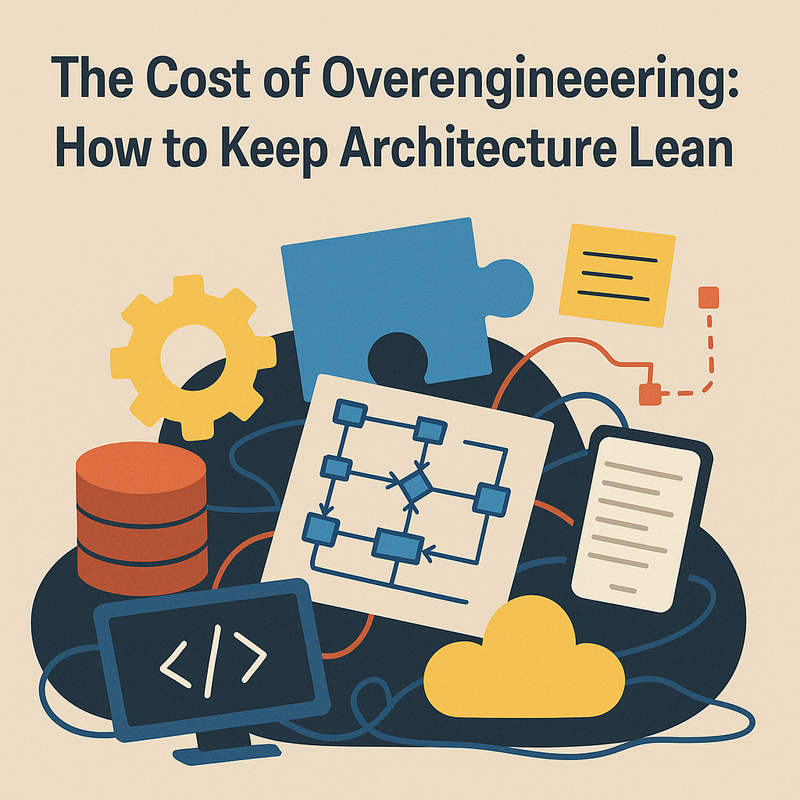May 18, 2025
The Cost of Overengineering: How to Keep Architecture Lean

May 18, 2025

Let’s be honest—software architecture sometimes feels like a game of 4D chess, where every move echoes down a hallway of future regrets. You plan for scale, resilience, clean abstractions… but before you know it, your “elegant” system has become an overengineered maze that even your future self resents.
So how does a well-meaning team end up with a tangled web of microservices, message queues, and abstractions no one actually needs? More importantly—how do we not end up there?
Let me explain.
Here’s a scenario that might feel uncomfortably familiar: you’re building a modest internal app—let’s say, a dashboard for ops. It’s going to be used by five people. Someone (maybe you) suggests splitting the backend into six microservices “to keep things modular.” A few weeks later, you’ve got Redis, Kafka, a service mesh, a tracing setup, and CI pipelines that occasionally catch fire.
For what? A dashboard.
This isn't just theoretical. I once consulted for a team that had more Helm charts than actual users. Every feature was wrapped in an event-driven handler, feeding into an event bus that… no one listened to. It was elegant on paper, but in reality, it was like building a Formula 1 car to fetch groceries.
That’s the trap of overengineering: it solves problems you don’t have yet, and introduces ones you definitely didn’t ask for.
Microservices are fantastic—when you actually need them. But premature decomposition is a classic footgun. You don’t get loose coupling for free; you get latency, distributed debugging, operational complexity, and a bunch of meetings about schema versions.
Here’s the thing: most teams adopting microservices are trying to scale people, not code. But if your team is five backend devs sitting in one Slack channel, breaking your app into a dozen tiny pieces is just busywork. You’ll end up building internal tooling to manage the tooling that manages the other tooling. It’s turtles all the way down.
Sometimes? A monolith is the most efficient architecture you’ll ever design.
There’s this other trend that sneaks in when people want to feel “modern.” Event-driven architecture. Don’t get me wrong—Kafka, RabbitMQ, SNS/SQS—they all have their place. But publishing events for CRUD operations just to say you're "event-driven"? That’s just ceremony.
I’ve seen systems where clicking a button in the UI triggered five asynchronous handlers that passed around protobufs like a game of hot potato—just to update a row in Postgres.
If you're not dealing with genuine concurrency, long-running jobs, or decoupled domains—skip the event circus. A simple API call and a transaction will save you days of engineering grief.
Here’s a hard truth: most “forward-thinking” architecture is emotional, not technical. We add abstraction layers and patterns not because we need them today, but because we’re afraid of tomorrow.
Sure, maybe. But maybe you’ll rewrite it in 18 months anyway. Or your company pivots. Or you realize that supporting two databases was never actually the bottleneck—it was onboarding, or testing, or just plain miscommunication.
Sometimes, your real architectural constraint isn't technical at all. It's human.
Lean architecture isn’t just about writing less code. It’s about writing the right amount of code—at the right time. Here are a few grounding principles that help:
And honestly? Talk to your team. A short hallway chat might prevent you from going full Inception on your data access layer.
There’s a saying in architecture: “The easiest way to scale is not to need to.”
Keeping things simple isn’t about avoiding complexity altogether—it’s about recognizing which complexity actually earns its keep. Because every extra queue, container, or caching layer comes with invisible baggage: uptime risk, cognitive load, and the creeping feeling that you need a diagram just to explain what the login flow does.
So next time someone suggests breaking apart a monolith, or abstracting the config loader, or adding another queue—ask them: what problem are we solving right now?
If the answer is fuzzy, maybe it’s not a problem worth solving yet.
Want to keep your architecture lean?
Start with trust—in your team, your process, and your ability to refactor when it really matters. Overengineering isn’t inevitable. But it is seductive.
And you know what? That dashboard probably doesn’t need Kubernetes.